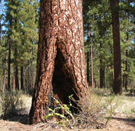Covington Testimony July 16, 2002
Testimony of Dr. William Wallace Covington, regarding the Wildland Firefighting and National Fire Plan, before the US Senate Energy and Natural Resources Committee
Tuesday, July 16, 2002
Full text [here]
Selected excerpts:
Chairman Bingaman, and members of the Committee, thank you for this opportunity to testify on a subject of personal importance to me and of critical importance to the health of our nation’s forests and the people and communities that live within them.
My name is Wallace Covington. I am Regents’ Professor of Forest Ecology at Northern Arizona University and Director of the Ecological Restoration Institute. I have been a professor teaching and researching fire ecology and restoration management at NAU since 1975. I chair Arizona Governor Jane Dee Hull’s Forest Health/Fire Plan Advisory Committee and am a member of the National Commission on Science for Sustainable Forestry.
I have a Ph.D. in forest ecosystem analysis from Yale University and an M.S. in ecology from the University of New Mexico. Over the past 27 years I have taught graduate and undergraduate courses in research methods, ecological restoration, ecosystem management, fire ecology and management, forest management, range management, wildlife management, watershed management, recreation management, park and wildland management, and forest operations research. I have been working in long-term research on fire ecology and management in ponderosa pine and related ecosystems since I moved to Northern Arizona University in 1975. In addition to my publications on forest restoration, I have co-authored scientific papers on a broad variety of topics in forest ecology and resource management including research on fire effects, prescribed burning, thinning, operations research, silviculture, range management, wildlife effects, multiresource management, forest health, and natural resource conservation.
My testimony will focus on the implementation of the National Fire Plan and the urgent need to increase the pace and size of forest restoration treatments to reverse the trend of increasing catastrophic wildfires. I will outline a three-step approach to help achieve this goal…
It is an unfortunate set of circumstances that have led to this hearing. Scientists have predicted the current forest crisis for the last 75 years. In 1994 I was senior author on a review paper in which I stated that we could anticipate exponential increases in the severity and extent of catastrophic fire. It is not a prediction I ever wanted to come true. In that same paper, I also suggested that we have a narrow window of 15-30 years to take preventative actions to restore forest health, minimize the loss of civilian and firefighter lives, and the mounting damage to our nation’s natural resources.
Protecting Communities And Saving Forests
Bonnicksen, Thomas M. Protecting Communities And Saving Forests–Solving the Wildfire Crisis Through Restoration Forestry. 2007. Published by the Forest Foundation [here].
Full Text and additional Restoration Forestry information [here]
Selected excerpts:
Restoration forestry is a vision for the future rooted in respect for the past. Thus, restoration forestry uses the historic forest as a model for the future forest. No scientist, forester, or environmental activist could conceive of more beautiful or diverse and sustainable forests, with more wildlife, than those found by the first European explorers. Restoration forestry aims to recover our nation’s forest heritage while also restoring the productive and harmonious relationship between people and forests that existed in historic forests.
Restoration forestry is defined as restoring ecologically and economically sustainable forests that are representative of landscapes significant in America’s history and culture. These forests also should serve society’s contemporary need for wood products and other forest values.
The goal of restoration forestry is to restore and sustain, to the extent practical, a forest to a condition that resembles, but does not attempt to duplicate, the structure and function of a reference historic forest. The term “reference historic forest” means the way a whole forest appeared spreading over a landscape, with all of its diversity, at or about the time it was first seen by European explorers.
The forests explorers found provide the most scientifically sound reference historic forest for the United States. These reference historic forests were inherently sustainable and diverse, represented thousands of years of development and human uses, existed during a period with a similar climate, and are more easily documented than forests from an earlier time.
A reference historic forest does not represent a particular point in time. It represents a period and the variations in forest structure that characterized that period. The historic period for a reference forest varies by region because the age of exploration lasted several centuries, ending in the late eighteenth century.
